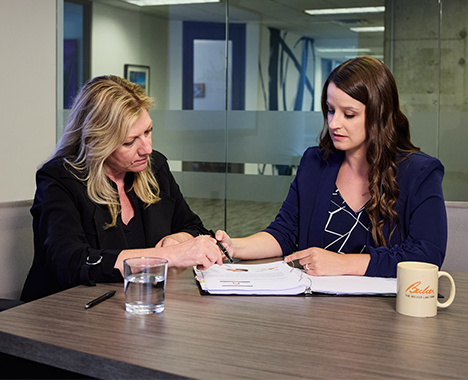Medical providers take an oath to do no harm and must use their education, experience, and skill to take care of the mother and the unborn baby during pregnancy, labor, and delivery. They are obligated to comply with what is called the standard of care. That means that these health care providers must act as other reasonable health care providers would act in similar situations.
When they fail to follow the standard of care, which is taught during medical school, nursing school, and on-the-job training, life-altering injuries can occur. Medical malpractice may be the fault of a doctor, midwife, nurse, pediatrician, family doctor, obstetrician, or another medical provider. The Becker Law Firm can help you determine who is liable for your damages.
Call us at 216-621-3000 or contact us online for a free initial consultation with one of our medical provider negligence attorneys in Ohio.
Types of Medical Provider Negligence
- Hospital and obstetrical nurse lawsuits: Nurses are the first line of defense during labor and delivery—obstetrical nurses are typically the ones responsible for the minute-by-minute monitoring of the mother and baby. They are the ones who must notify the obstetrician when anything unusual or dangerous occurs, particularly signs of fetal distress. Modern nurses are not mere servants of the obstetrician but have a separate duty to their patients. They cannot blindly follow obstetrician orders but must make their own evaluation and seek assistance through the chain of command if the obstetrician ignores a medical problem.
- Anesthesiologist lawsuits: The majority of births use some kind of anesthesia, whether an epidural or general anesthesia. These drugs carry certain inherent risks, but those risks are magnified when the anesthesia is incorrectly administered.
- Birth center and midwife lawsuits: Many women seek natural births, sometimes away from the tubes and cords of a hospital delivery. In many cases, women can have those types of deliveries. Midwives and birth centers have an obligation to carefully screen their patients, warn them about the risks associated with a birth center or midwife delivery, and have emergency protocols in place.
Examples of Nurse Negligence
Nurses must pay attention to the health of the baby during labor and delivery, especially by monitoring the electronic fetal monitoring strips for signs of fetal distress (evidence that the baby may not be getting enough oxygen). Nurses sometimes fail to recognize signs of distress or fail to notify the obstetrician of problems. Nurses must also continuously evaluate the mother for medical problems, such as fever, infection, and bleeding. Failure to do so can cause wrongful death of the mother, or medical complications due to postpartum negligence.
OB nursing negligence can take many forms, including:
- Failure to turn off the Pitocin
- Failure to interpret fetal monitoring strips appropriately
- Failure to alert the physician to signs of fetal distress
- Failure to engage in intrauterine resuscitation
- Failure to anticipate a depressed newborn and request a pediatric resuscitation team present at birth
- Failure to call in the obstetrician in a timely manner
- Failure to clear an infant’s lungs promptly after birth
- Failure to pursue chain of command when the physician does not take steps to protect the mother and unborn baby
If the nurse sees a problem and the doctor fails to do anything about it, the nurse has a duty to go up the hospital’s chain of command to find someone who can intervene on behalf of the patient. Nurses, especially obstetrical nurses, are educated professionals who should be able to identify dangerous situations. If the doctor won’t help, they must seek assistance from the charge nurse, the nurse manager, the chief of the department, the chief of staff, and the director of the hospital, if necessary.
Examples of Midwife Negligence
In our experience, birth injuries caused by midwives usually result from one or more of the following:
- Patient criteria: Midwives must screen their patients very carefully. Not all women are candidates for home births or midwife-assisted births, particularly those who are high risk. In particular, midwives are more likely to ignore the dangers of vaginal birth after cesarean (VBAC).
- Informed consent: Midwives must clearly and openly disclose all significant risks to a midwife-assisted delivery.
- Negligent credentials: Some midwives do not meet minimum state standards or licensing requirements.
- Failure to assess the baby’s condition: Midwives may ignore warning signs in an effort to provide a natural birth, at significant risk to the baby or delivering mother
- Failure to have in place and/or follow adequate policies and/or procedures regarding emergency delivery of babies
How to Choose a Midwife
For women who are thinking about using a midwife, there are a few things to keep in mind in order to avoid dangerous situations:
- Find out whether you are high risk: If you have any high-risk conditions, you generally should not use a midwife. Women with high-risk factors should opt for careful medical monitoring and care in order to increase the risks of a successful delivery and a healthy baby.
- Research your midwives: Each state has different rules about midwife education and certification. Find out what they are and make sure your midwives have the appropriate credentials. Also, it is a good idea to determine whether your midwife has had any medical malpractice lawsuits, criminal charges (sometimes midwives are charged criminally for the deaths of babies), or negative actions taken on his or her license. Most states have electronic internet databases that allow searches by name.
- Know what is allowed: Most states have requirements about home births and births away from hospitals. Some states, for example, permit midwives to deliver babies in a mother’s home but require a doctor or certified nurse to be present. Some states permit midwives to manage a pregnancy but require collaboration with an obstetrician.
- Make sure your midwife has a backup plan: In the event of an emergency, midwives should have a backup plan. Do they have equipment that they can use if necessary (electronic fetal monitoring, Doppler, oxygen tanks, etc.)? Do they have an obstetrician on-call? Is there a hospital nearby?
- Find out if your midwife has malpractice insurance: This is a sensible precaution. If your midwife does not have at least $5 million in medical malpractice coverage, you should find another midwife. If your midwife does something wrong, a good insurance policy could mean the difference between expert medical care and state-assisted medical aid for your child.
Family Doctor Negligence
Family doctors must know their limitations. They have an obligation to refer the expectant mother to a qualified obstetrician, particularly in these high-risk situations:
- Advanced maternal age
- Twins, triplets, and multiples
- Suspected large baby (macrosomia)
- Vaginal birth after cesarean (VBAC)
- Premature, prolonged, and preterm rupture of membranes
Family doctors, like obstetricians, must be able to anticipate expected birth complications like shoulder dystocia. Because shoulder dystocia and other medical complications can occur without any warning, family doctors are expected to perform with the same degree of care as obstetricians.



